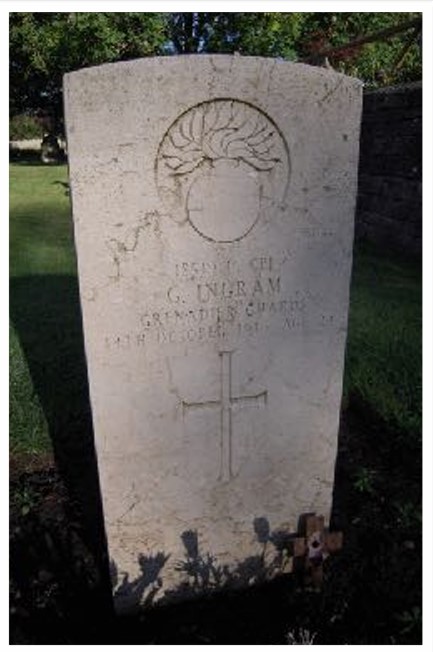2nd Battalion, Grenadier Guards

George Ingram was born on 6 August 1891 at Shorncote (situated halfway between Kemble and South Cerney).
After leaving school he worked as a farm labourer and on 1 May 1912, he joined the Gloucestershire Constabulary, as a Constable and was given the Warrant No 3997: four months later he was posted to the Stow Division and later transferred to the Gloucester Division.
On 7 September 1914 he resigned from the police force, to allow him to voluntarily enlist in the Army. He was posted to the 2nd Battalion, Grenadier Guards and was allocated the number 18519.
He was posted to France on 24 May 1915 as part of a replacement draft to cover losses sustained in an attack near to Le Touret on 18 May 1915.
Later that year, on 20 August, the battalion became part of 1st Guards Brigade, Guards Division. In mid-October the battalion took part in an action to capture German positions at the Hohenzollern Redoubt, near to Loos. It is believed that George Ingram came through this un-scathed and was later promoted to Lance Corporal.
It is known that George Ingram was wounded during the Battle of the Somme but in the absence of a surviving Service Record it is not possible to identify the specific action.
On 15 September the 2nd Grenadiers took part in an attack on the village of Ginchy, acting as a support battalion, following up on an assault by another Guards’ battalion and passing through the village.
On 24 September the battalion went into trenches near to the Ginchy-Lesboeufs Road and at 12.35pm on the 25th they attacked. The assault was held up by uncut wire hidden in fields of crops, undamaged by the supporting barrage and four of the battalion’s of[icers went forward to cut gaps: three were killed in the process and one wounded. However, the gaps created enabled the assault to take place. It would appear likely that Lance Corporal Ingram was wounded in either one of these actions.
George was sent back to England and admitted to Southmead Hospital, Bristol, where he died of his wounds on 14 October 1916, aged 25. He was buried in Kemble Church churchyard, where a standard CWGC headstone marks his grave. He is also commemorated on the Kemble War Memorial and on the Roll of Honour of men of the Gloucester Police Division who served in the Great War of 1914-1918.
Graham Adams
(from the Gloucestershire War Graves Project biographical archive)
